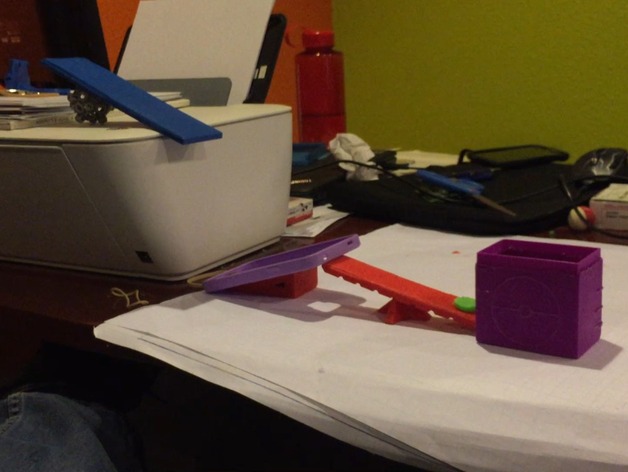
Rube Goldberg Device Lesson - with Simple Machines Education Kit and More!
thingiverse
Project #4 - Rube Goldberg Device In this project, students will design and build their very own Rube Goldberg device in small groups. Using pre-created 3D printed parts and other usable items like dominos, rope, wiring, etc., students can engage in an exploratory experiment to test the physics of their device. The sample 3D STL file included is borrowed from user timelapse21 on Thingiverse: https://www.thingiverse.com/thing:1378432 Print Settings: Printer: Flashforge 3D Creator Pro Rafts: Yes Supports: Yes Resolution: .27 Infill: %15 Notes: It's recommended to print these parts at slower speeds to ensure accuracy. The infill percentage can be adjusted based on other supporting materials and the overall need for the Rube Goldberg device. Post-Printing: Print preview of all parts assembled. How I Designed This: Generally, Rube Goldberg devices are created by starting with a simple task that one would like to achieve. Then, additional steps are added until the creator feels satisfied with all mechanisms that will lead up to the final step. Standards: NGSS Overview and Background: Students in a physics/physical science/engineering setting will engage in a lab activity involving the creation of a Rube Goldberg device. This project is ideal for students covering basic mechanics, serving as an exploratory lesson that can help establish pre-existing beliefs about simple machines and test physical principles in a fun, creative way. Objectives: * Students will learn about the Rube Goldberg device and different simple machines that transfer physical properties across systems. * Students will create a fully functional Rube Goldberg device that converts energy from one system to another to complete a simple task at the end of the chain. Skills Learned (Standards): HS-PS3-3: Design, build, and refine a device that works within given constraints to convert one form of energy into another form of energy. Clarification Statement: Emphasis is on both qualitative and quantitative evaluations of devices. Examples of devices could include Rube Goldberg machines, wind turbines, solar cells, solar ovens, and generators. Examples of constraints could include use of renewable energy forms and efficiency. Assessment Boundary: Assessment for quantitative evaluations is limited to total output for a given input. Assessment is limited to devices constructed with materials provided to students. Lesson Plan and Activity: Step 1: Pass out worksheets to students. Step 2: Review simple machines worksheets. Step 3: Split students into groups of 4-6. Step 4: Reveal all usable components for students. Step 5: Allow students to brainstorm and draw up sketches of possible devices. Step 6: Divide up supplies amongst all teams. Step 7: Allow students the opportunity to create the device over two class periods. Step 8: Test all devices and record results. Step 9: Evaluate devices and score each group. Step 10: Debrief the activity and connect to upcoming learning objectives. Materials Needed: * Lab area * Timer (phone apps can work too!) * Tape measure Duration of Lesson: * 1-2 hours to teach and review worksheets * 4+ hours to create Rube Goldberg devices and test them for functionality (can be spread over 2-4 classes) * 1 hour to evaluate videos and debrief project Preparation: The teacher MUST print copies of the different simple machines. The teacher MUST find/make available additional supporting items such as string, blocks, wires, coils, springs, glues, popsicle sticks, etc. Rubric and Assessment: See attached rubric on Rube Goldberg Machine handout. References: http://www.nextgenscience.org/topic-arrangement/hsenergy - Next Generation Science Standards (NGSS)
With this file you will be able to print Rube Goldberg Device Lesson - with Simple Machines Education Kit and More! with your 3D printer. Click on the button and save the file on your computer to work, edit or customize your design. You can also find more 3D designs for printers on Rube Goldberg Device Lesson - with Simple Machines Education Kit and More!.
